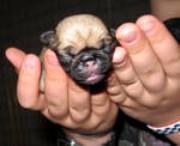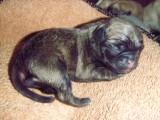Pug Dog Pregnancy
Overview
Whether you are purposefully breeding or your Pug may have accidentally become pregnant, this page will guide you through the basics of what to expect, how to know a Pug is pregnant, the labor process and care.
Signs that a Pug is Pregnant
You might be wondering if your Pug is pregnant and perhaps you can not get an appointment with the vet immediately. A dog's pregnancy is a fast one compared to humans; therefore a dog will show signs of being pregnant very quickly.
The following are signs and symptoms that a Pug is pregnant:
Week 1 -
At this early stage, there will usually be no signs. Towards the end of Week 1, some dogs may have slight nausea that causes a decreased appetite.

1.5 week old Pug newborn puppy
Photo courtesy of: Tammy Jones
Weeks 2 and 3 -
Signs will begin to emerge. Some will be minimal, causing you to question if there are truly changes:
- She may be more tired than usual
- Her stomach may seem slightly swollen
- She may clean herself much more than normal
- Her nipples on her tummy seem larger than before
- During Week 2 there may still be some 'morning sickness' that causes nausea. This is often fleeting and a stronger, more heartier appetite will emerge as she transitions into Week 3
Week 4 -
Signs are now very clear:
- The Pug's stomach will be distended, clearly showing that she is carrying a litter
- Her nipples will be enlarged and darkened as her body prepares for nursing; some that were previously flush with the skin will now be popped out. For those that have had been bred before, nipples may hang down as they fill with colostrum
- She will have strong nesting tendencies, wanting to prepare for the impending birth.
- Her appetite will have increased greatly. Pregnant dogs often eat up to twice as much as normal at this point.
Weeks 5 and 6:
Nearing the end of the gestation period, a Pug may shows the following signs:
- She may tired out very easily now
- The Pug often wants to remain at home and will usually be less social. It is normal for her to retreat to a quite spot to rest
- There will be a final weight gain of approximately 10% of her normal body weight; this will vary depending on the litter size. This will be comprised of not just the pups (each will be under one pound, weighing only mere ounces) but also will fluids (water, amniotic fluids) and tissue (amniotic sacs that surround each fetus).

Wubbzy after giving birth - nursing her newborns
Photo courtesy of Laura Velez
Pug Pregnancy Facts
- A Pug will be pregnant for an average of 63 days, a range of 60 to 65 days is considered normal
- If your Pug is pregnant for more than 67 days, be sure to bring her to the veterinarian
- The average sized litter for Pugs is 4 to 6 puppies, though this can vary from 1 to 9 and still be considered normal.
- An x-ray (ultrasounds are not typically done) performed after 6 weeks (the fetus's bones are not calcified before then) will show you how many puppies there will be - this is very important so that you know that all came out during the birthing process
Possible Risks
1) Since a Pug dog has a large head in comparison to its body, there is a chance that the dam will need to have a cesarean section.
As soon as you know your dog is pregnant, you must have your veterinarian keep a close eye on her progress. Her hips and pelvis will be evaluated and judged if there is enough width for a natural birth.
Your vet may choose to plan a C-Section or wait to see if there are any warning signs that the pups will not fit through the birth canal based on how many fetuses there are and their predicted size at the time of delivery.
2)
She will need to be monitored for possible blood sugar irregularities
3)
Pregnant dogs are at a higher risk of infection of the reproductive tract
Care for a Pregnant Pug Dog
Food - Pregnant Pugs will need to eat quite a bit more food than usual. Their appetite will increase around week 3 or 4. Do not be concerned about feeding her too much at this time; she will crave the necessary calories needed for her pups and it will be your job to supply them.
Everything that your Pug eats will be transferred to her growing puppies; therefore she should be allowed to eat as much as she wishes, when she wishes. Do please be sure to keep these meals and snack on the healthy side. While pregnant dogs do need a bit more fat in the diet, the goal is to increase nutrients while keeping food wholesome and healthy. Following home cooking suggestions, adding fresh raw baby carrots or steamed potatoes can be nutritious add-on ingredients to her diet.
Expect a pregnant Pug to eat 25 to 50% more than normal.
Supplements-
There is no need to offer her additional vitamins and mineral supplements; and in fact doing so can cause health issues to both her and the fetuses.
Do not give her extra calcium - This has been shown to:
- Increase her odds of developing eclampsia - a dangerous, life-threatening condition involving seizures and high blood pressure
- More difficult delivery
- Joint abnormalities in the puppies

"Tiny little newborn Pug puppy" Tinkerbell
Photo courtesy of: Laura Valez
Activity -
Unless there are any exercise restrictions set in place by the veterinarian, you will want to continue to walk your Pug daily at a nice pace; albeit perhaps a bit slower. This will allow her to stay fit and becoming sedentary can lead to a sore joints and muscles.
Do not allow her to jump down from the sofa or any other height that would cause a jarring (this should be the rule for all Pugs). During the final 2 weeks - depending on how many pups she is carrying - she may have trouble maneuvering around and walks can be put on pause at this time.
Comfort -
If your Pug has been sleeping in your bed, she will need her own personal space now. Her instinct to nest will be strong and the pregnancy will cause her to want to retreat to a 'nest' to rest.
A quality canine bed
with one or two soft baby blankets (these are a good size for a dog to use as nesting materials), set in the corner of the family room will do just fine. Be sure to not set her up too far away from the 'action' as this will cause her to feel isolated and stressed.
Other Dogs -
If the sire is in the house, separate the two dogs starting at the beginning of Week 5. He can re-join her when the pups are 4 weeks old - with your supervision. Once they are fully weaned, he can have full access.
If your pregnant Pug seems to be bothered by the presence of other dogs in the house (male or female), surround her resting spot with portable baby gates.
Your Dog Giving Birth At Home
If it is determined by your vet that your Pug is able to give birth at home, you can prepare for this by sectioning off a quite corner in a room or creating a whelping box by placing a large canine bed inside a good-sized cardboard box with one side cut out for access.
The bottom of the whelping box can have plastic layering placed down, followed by layers of clean newspaper; as the papers become bloodied and soaked with fluid, they can be quickly removed, revealing fresh paper.
Supplies
In the prepared room, be sure to have all supplies close at hand. you will not want to leave the dam to run and grab a necessary item. If possible, have an assistant with you since this is not a job that one should handle alone.
The items that you should have are:
-Clean towels
-Sterilized thread
-Thermometer
-Disinfection spray
-A suction bulb
-A small dropper (like the kind used to give babies medication)
-Heating pad
Signs it is Time
You'll want to start taking her temperature twice per day, every day, starting on day 55. This is done with a canine rectal thermometer.
When your Pug dog's temperature drops below
100 degrees (37.77 Celsius) she will be ready to give birth within the next 24 hours.. Sometimes the temperature will drop and then raise...while rare it does happen.
Labor
Allow the birthing to take place naturally, offer her water but no food (she would most likely throw it up).
It will be normal for her to pant heavy and whine or whimper. Some dogs shiver. Active labor can last from 2 to 12 hours.
Delivery
Each puppy will be born encased in his or her own amniotic sac; the sac may break or it may to be opened. It is canine instinct for the dam to tear it open using her teeth, if she does not do this, you must carefully assist.
Crying and whimpering during labor is normal, however afterward the dam should be peaceful and rather quiet. Signs of distress after giving birth could point to an emergency issue and the veterinarian should be contacted ASAP.
Puppies may be born in rapid succession; though there may be up to 2 hours in-between each pup being pushed out.
It's best to let nature follow its course, only stepping in if there is a true need. You may need to gently help pull out the puppies with extreme care. Have your vet on call, in case a pup becomes wedged.
After Delivery
If the dam does not bite the umbilical cord, it should be "cut" by using sterilized thread. You will tie the thread around the cord and pull quickly on both ends.
Once the puppies are born, the mother will clean them. Her cleaning will help to stimulate their blood circulation. Once all of the puppies are out, the dam will push out the placenta. Once this is done, the birthing process is over. It may seem a bit disturbing, however sometimes a dam will ingest the materials that are pushed out of her including the amniotic sac, umbilical cords and the placenta.
You may need to use the suction bulb to take mucus out of the puppies lungs and throat the dam does not clear this herself.
Keep a close eye on your Pug and the puppies. Make sure that the puppies are breathing; if their tongues are blue, this means that they are in distress. In addition, they must be able to reach their mother's nipples to nurse; you can gently move them over to this spot if they need help.
In the event that a dam seems disinterested in her pups or shows any aggressive behavior, take the puppies to a warm, soft and safe area and supply them with much needed milk. This will be administered using a dropper.
Allow the dam to rest as much as she needs after giving birth. Most dogs bounce back fairly quickly after giving birth. Look for red flags signs such as bleeding, weakness and fever. These are red flags to bring her to the veterinarian ASAP.
As the weeks go by, she will need you to "babysit" her puppies more and more often as she takes much needed breaks.

